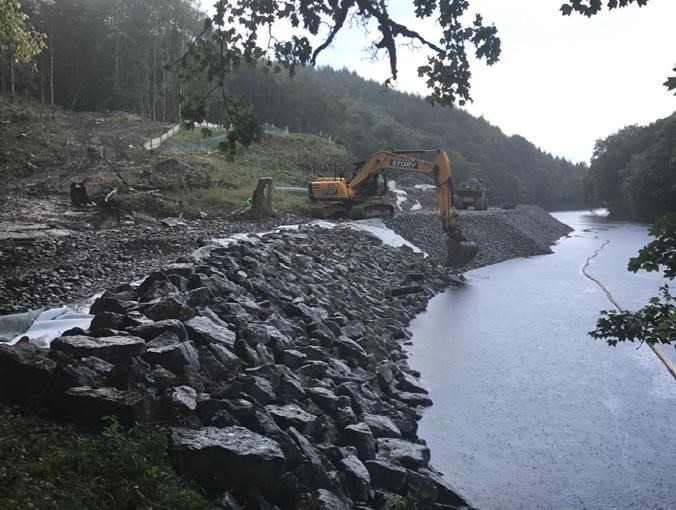Wednesday 18 Oct 2017
Rock armour protecting the Settle-Carlisle line from Britain's topsy-turvy weather
- Region & Route:
- | North West & Central
Huge boulders are being used to protect Britain's best-loved railway from the storm-swollen torrents of the River Eden in Cumbria.
Running 70 metres above the river is the iconic Settle-Carlisle line, which was forced to close for more than a year in February 2016 after a 500,000-tonne landslip requiring the most complex and largest railway repair in Network Rail's history.
As part of the final phase of its £23m repair, Network Rail's orange army has packed 20,000 tonnes of "rock armour" into the banks of the River Eden to guard against erosion caused by future heavy rainfall.
Such erosion triggered last year's land slip at Eden Brows, just north of Armathwaite, near Carlisle. The line reopened in March this year after more than a year of work to secure a vast concrete track base into the steeply-sloping bedrock of the Eden gorge using 226 20-to-30-metre-long steel piles.
Now if the earth gives way at this location in future, the railway will not. With the railway secured, Network Rail have since installed rock armour for added resilience.
Martin Frobisher, managing director of Network Rail’s London North Western route, said: “The future of this vital economic artery through Britain’s most beautiful landscape is secure, thanks to the work of our brilliant orange army.
"With the major repair completed earlier this year, the rock armour gives this location a further layer of resilience against the increasingly topsy-turvy British weather."
In addition to the rock armour, silt booms and new drains have been installed into the foot of the embankment. This final phase of the Eden Brows repair is set to be completed in March 2018.
Notes to Editors
Eden Brows repair facts:
- Tricky location: work site set-up required more than a mile of access roads across farmland.
- Ground investigation: multiple boreholes drilled 30m deep on the embankment slope.
- Challenge: a major engineering solution on a 70m embankment continuing to slip.
- Expertise needed: geotechnical, structures, drainage and track designers.
- Clearing the 70m slope of vegetation.
- Excavating 4m below track level before installing piles.
- 16,000 tonnes of spoil removed from site.
- Installing a concrete guide wall to assist with piling works
- 226 steel-cased piles. Laid end to end the piles would stretch more than 4km.
- 1,300 cubic metres of concrete poured.
- Installation of five sections of one metre-thick reinforced concrete slabs.
- 3m retaining walls: 180-tonne steel reinforcement; 1,200m cubic metres of concrete.
- Waterproofing of the slabs and walls and installation of new drainage.
- Landscaping above the slabs: 6,000 tonne of stone; 3,000 tonnes of railway ballast.
Contact information
Passengers / community members
Network Rail national helpline
03457 11 41 41
Latest travel advice
Please visit National Rail Enquiries
Journalists
Network Rail press office - North West & Central Region
0330 854 0100
NWCmediarelations@networkrail.co.uk
About Network Rail
We own, operate and develop Britain's railway infrastructure; that's 20,000 miles of track, 30,000 bridges, tunnels and viaducts and the thousands of signals, level crossings and stations. We run 20 of the UK's largest stations while all the others, over 2,500, are run by the country's train operating companies.
Usually, there are almost five million journeys made in the UK and over 600 freight trains run on the network. People depend on Britain's railway for their daily commute, to visit friends and loved ones and to get them home safe every day. Our role is to deliver a safe and reliable railway, so we carefully manage and deliver thousands of projects every year that form part of the multi-billion pound Railway Upgrade Plan, to grow and expand the nation's railway network to respond to the tremendous growth and demand the railway has experienced - a doubling of passenger journeys over the past 20 years.
Follow us on Twitter: @networkrail
Visit our online newsroom: www.networkrailmediacentre.co.uk

